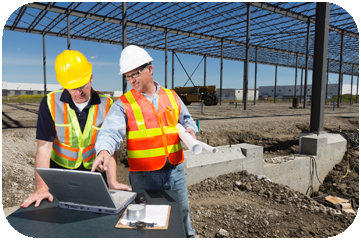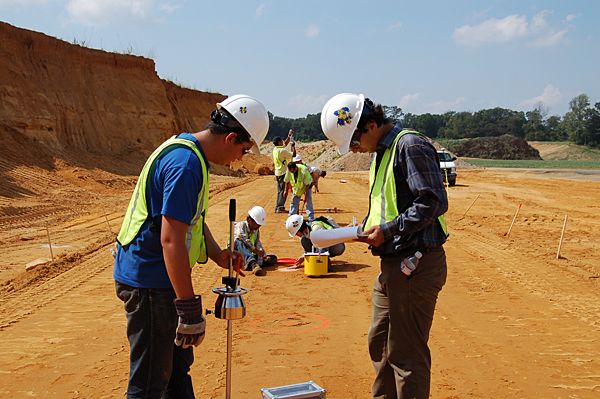Project Geotechnical Engineer for Tailored Website Analyses
Wiki Article
A Comprehensive Assessment of the Providers Given by Consulting Engineers in the Field of Geotechnical Design: From Site Investigation to Project Execution
Consulting designers in geotechnical design play a crucial role in the successful implementation of building and construction jobs, beginning with detailed website investigations that expose vital subsurface conditions. Their knowledge extends to soil residential property assessments, ecological influence assessments, and the cautious surveillance of project application, making sure alignment with safety and security and sustainability standards.Significance of Geotechnical Design
Geotechnical engineering is an essential discipline that underpins the safety and sustainability of civil facilities jobs. By understanding the mechanical actions of soil and rock materials, geotechnical designers examine the suitability of websites for numerous buildings, including buildings, bridges, and dams. This fundamental evaluation guarantees that structures can stand up to ecological elements and lots without experiencing failure.The relevance of geotechnical design expands beyond plain architectural safety; it additionally incorporates environmental stewardship. Correct geotechnical analyses add to decreasing the ecological influence of building. With cautious evaluation of soil homes and groundwater problems, engineers can develop structures and maintaining frameworks that minimize risks such as disintegration and landslides, advertising long-term stability.
Additionally, geotechnical design plays a vital duty in job cost monitoring. geotechnical works. By identifying possible issues early in the layout phase, designers can advise ideal remedies, therefore staying clear of pricey hold-ups and redesigns throughout construction. This proactive method not only boosts job efficiency however additionally considerably decreases risks linked with unforeseen website conditions
Site Investigation Methods
Reliable site examination strategies are important for collecting accurate information concerning subsurface problems before building and construction. These techniques facilitate the understanding of the geological and hydrological setting, which is vital for making sure the stability and security of proposed structures.Common approaches employed in site investigations consist of borehole drilling, which allows engineers to draw out dirt samples at different depths, offering insights into stratification and material types. On top of that, geophysical studies, such as seismic refraction and electrical resistivity, offer non-invasive ways to assess subsurface qualities over larger areas. These approaches can aid determine anomalies without substantial excavation.
Examination pits are one more beneficial strategy, giving direct monitoring of dirt layers and making it possible for in-situ testing. geotechnical works. This approach is specifically helpful for superficial excavations and can help analyze groundwater levels. Cone penetration tests (CPT) are progressively used, as they offer continual profiles of dirt resistance, which aids in figuring out dirt strength and layering.
Each of these strategies plays a vital duty in creating a thorough understanding of site problems, enabling consulting designers to make informed decisions and suggestions throughout the job lifecycle. Exact data collection during the website examination phase is essential to mitigating threats and making Learn More sure successful project implementation.
Dirt Building Analysis

The analysis process generally involves a mix of lab tests and field investigations. Key buildings such as shear toughness, compressibility, leaks in the structure, and wetness web content are examined to determine the dirt's suitability for building and construction objectives. Conventional examinations, including the Atterberg limits, Proctor compaction, and triaxial shear examinations, are generally utilized to collect information on soil habits.
Along with these examinations, in-situ methods such as the Requirement Infiltration Test (SPT) and Cone Penetration Examination (CPT) offer important insights into soil stratigraphy and density. The outcomes of these evaluations educate engineers concerning possible difficulties, such as soil liquefaction or negotiation, enabling them to create appropriate mitigation approaches.
Environmental Impact Evaluation
Ecological effect analysis plays an important function in the planning and execution of design tasks, particularly in geotechnical engineering. This procedure involves analyzing the prospective ecological consequences of proposed jobs on soil, water, air high quality, and surrounding environments. Consulting designers utilize numerous approaches, including site evaluations, modeling, and field studies, to identify and quantify these influences.The examination usually begins with the recognition of baseline environmental problems, which functions as a referral for anticipating prospective adjustments. Engineers assess elements such as erosion, groundwater contamination, and habitat disruption, ensuring that all pertinent environmental guidelines and standards are complied with throughout the task lifecycle. Stakeholder involvement is likewise an indispensable component of the examination procedure, as it cultivates communication in between job programmers, regional areas, and regulatory bodies.
In addition, mitigation strategies are created to attend useful source to recognized effects, allowing engineers to suggest options or adjustments to project layouts that boost sustainability. This proactive approach not just reduces adverse effects on the environment but additionally advertises public count on and conformity with ecological regulations. Inevitably, efficient environmental influence analysis reinforces the total honesty and feasibility of geotechnical design jobs, supporting responsible development techniques.
Task Execution and Tracking

Surveillance is a crucial component of task application. Engineers use numerous methods, such as instrumentation and area tests, to examine soil behavior and structural feedbacks in real-time. This continual surveillance enables the recognition of any inconsistencies from anticipated efficiency, enabling timely treatments to minimize threats.
Furthermore, seeking advice from engineers maintain open interaction with specialists and stakeholders throughout the process. Normal website assessments and progression reports ensure that all celebrations are informed concerning project condition and any arising problems. By promoting collaboration and transparency, getting in touch with engineers help with an extra effective implementation process, thereby boosting project outcomes.
Ultimately, reliable task application and surveillance not just maintain security and high quality requirements but additionally add to the general success of geotechnical tasks, ensuring they fulfill their designated objectives sustainably and responsibly.

Final Thought
To conclude, the duty of speaking with designers in geotechnical engineering includes a crucial sequence of solutions that make certain job success. From detailed site investigations to thorough soil residential property analyses and environmental influence evaluations, these professionals prepared for risk-free and lasting building practices. Continuous monitoring during project execution better ensures structural stability and stakeholder interaction. Ultimately, the diverse payments try this website of seeking advice from engineers are important in dealing with the intricacies of geotechnical difficulties in contemporary engineering projects.Report this wiki page